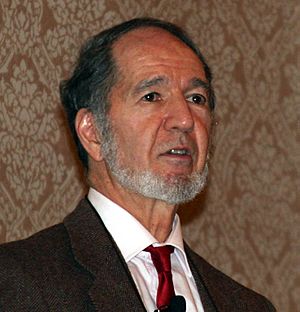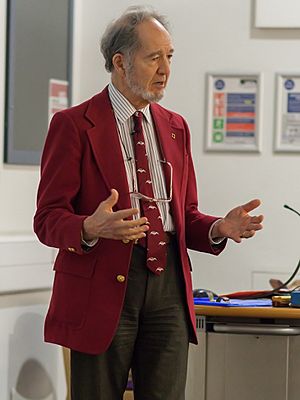Jared Diamond facts for kids
Quick facts for kids
Jared Diamond
|
|
|---|---|

Diamond in 2016
|
|
| Born |
Jared Mason Diamond
September 10, 1937 Boston, Massachusetts, U.S.
|
| Education | |
| Awards |
|
| Scientific career | |
| Fields | Physiology, biophysics, ornithology, environmental science, history, ecology, geography, evolutionary biology, and anthropology |
| Institutions | University of California, Los Angeles |
| Thesis | Concentrating activity of the gall-bladder (1961) |
Jared Mason Diamond (born September 10, 1937) is an American scientist, historian, and author. He is famous for writing books that combine science and history to answer big questions about human societies.
His best-known book is Guns, Germs, and Steel (1997). It won many awards, including the 1998 Pulitzer Prize, a famous prize for writing. Diamond is known for studying many different subjects, including biology, geography, and history. Because he knows so much about different topics, some people call him a polymath (a person with wide-ranging knowledge).
In 1999, he received the National Medal of Science, a top honor for scientists in the United States. He was a professor of geography at the University of California, Los Angeles (UCLA) for many years.
Contents
Early Life and Schooling
Jared Diamond was born in Boston, Massachusetts. His father was a doctor, and his mother was a teacher and musician. From a young age, Diamond had two main passions. He started learning piano when he was six. When he was seven, he became interested in birdwatching, which would become a lifelong hobby.
He went to Harvard College and later earned his Ph.D. (a high-level university degree) from Trinity College, Cambridge in England. His first area of scientific study was in physiology, which is the study of how living things work.
A Career of Many Subjects
Diamond's career has been very diverse. After finishing his studies, he became a professor of physiology at UCLA Medical School.
At the same time, he started a second career studying birds and the environment. He spent a lot of time in New Guinea, an island north of Australia, and the islands nearby. This work made him an expert in ornithology (the study of birds) and ecology (the study of how living things interact with their environment).
Later, Diamond began a third career as a writer and professor of environmental history and geography. He is famous for his ability to connect ideas from different fields to explain big patterns in human history.
Famous Books by Jared Diamond
Diamond is best known for his popular science books that are read by people all over the world.
The Third Chimpanzee (1991)
This was Diamond's first popular book. It explores how humans became so different from other animals. He points out that humans and chimpanzees share over 98% of their DNA. The book asks why we are so unique, looking at things like language, art, and farming.
Guns, Germs, and Steel (1997)
This is Diamond's most famous book. It tries to answer a huge question: Why did people from Eurasia (Europe and Asia) conquer people from other parts of the world, like the Americas and Australia?
Diamond argues that it was not because Eurasians were smarter or better. Instead, he says the answer lies in geography.
- Farming: Eurasia had more wild plants and animals that were easy to domesticate (tame for farming), like wheat, rice, cows, and horses. This allowed them to grow more food.
- Spread of Ideas: The Eurasian continent is wide and stretches from east to west. This shape made it easier for crops, animals, technology, and ideas to spread across long distances.
- Germs: Living closely with farm animals meant that Eurasians were exposed to many diseases, or germs. Over time, they developed resistance to these diseases. When they traveled to other continents, they brought these germs with them, which were deadly to people who had never been exposed to them.
The book was a huge success and was made into a television documentary by the National Geographic Society. However, some historians and anthropologists disagree with his ideas.
Why is ... Fun? (1997)
In this book, Diamond looks at features of human life that are very different from most animals. He explores why humans often form long-term couples (marriage), raise children together, and have unique social behaviors. The book discusses how these traits might have developed through evolution.
Collapse (2005)
In Collapse, Diamond investigates why some past societies disappeared while others survived. He looks at historical examples like the Maya in Central America and the Viking settlements in Greenland.
He argues that societies often collapse because of environmental problems, such as cutting down too many trees or overusing natural resources. The book serves as a warning and asks what we can learn from the past to avoid making the same mistakes today. Like his other books, Collapse was a bestseller and was also turned into a TV documentary.
The World Until Yesterday (2012)
In this book, Diamond explores what modern societies can learn from traditional societies, like hunter-gatherer groups. He looks at how they handle common human problems, such as raising children, settling arguments, and staying healthy. He suggests that some of their practices could be useful in our modern world.
Upheaval (2019)
In Upheaval, Diamond compares how entire nations deal with major crises to how individual people deal with personal challenges. He studies countries like Finland, Japan, and Germany to see what lessons can be learned about overcoming difficult times. He also discusses modern global threats like climate change.
Personal Life
Diamond is married to Marie Cohen. They have twin sons who were born in 1987. He is of Jewish heritage but does not actively practice the religion.
See also
 In Spanish: Jared Diamond para niños
In Spanish: Jared Diamond para niños
- Comparative history
- Environmental determinism



